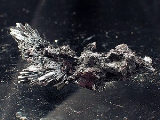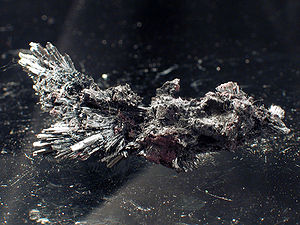
Antimonite
Encyclopedia
In chemistry
, an antimonite refers to salt
s of antimony
(III), such as NaSb(OH)4 and NaSbO2 (metaantimonite) which can be prepared by reacting alkali
with antimony(III) oxide, Sb2O3. These are formally salts of antimonous acid (antimonious acid
), "Sb(OH)3" whose existence in solution is dubious, and attempts to isolate it generally form Sb2O3.xH2O, antimony(III) oxide hydrate, which slowly transforms into Sb2O3.
In geology
, the mineral
stibnite
, Sb2S3, is sometimes called antimonite.
 They can be compared to antimonates, which contain antimony in the +5 oxidation state.
They can be compared to antimonates, which contain antimony in the +5 oxidation state.
Chemistry
Chemistry is the science of matter, especially its chemical reactions, but also its composition, structure and properties. Chemistry is concerned with atoms and their interactions with other atoms, and particularly with the properties of chemical bonds....
, an antimonite refers to salt
Salt
In chemistry, salts are ionic compounds that result from the neutralization reaction of an acid and a base. They are composed of cations and anions so that the product is electrically neutral...
s of antimony
Antimony
Antimony is a toxic chemical element with the symbol Sb and an atomic number of 51. A lustrous grey metalloid, it is found in nature mainly as the sulfide mineral stibnite...
(III), such as NaSb(OH)4 and NaSbO2 (metaantimonite) which can be prepared by reacting alkali
Alkali
In chemistry, an alkali is a basic, ionic salt of an alkali metal or alkaline earth metal element. Some authors also define an alkali as a base that dissolves in water. A solution of a soluble base has a pH greater than 7. The adjective alkaline is commonly used in English as a synonym for base,...
with antimony(III) oxide, Sb2O3. These are formally salts of antimonous acid (antimonious acid
Acid
An acid is a substance which reacts with a base. Commonly, acids can be identified as tasting sour, reacting with metals such as calcium, and bases like sodium carbonate. Aqueous acids have a pH of less than 7, where an acid of lower pH is typically stronger, and turn blue litmus paper red...
), "Sb(OH)3" whose existence in solution is dubious, and attempts to isolate it generally form Sb2O3.xH2O, antimony(III) oxide hydrate, which slowly transforms into Sb2O3.
In geology
Geology
Geology is the science comprising the study of solid Earth, the rocks of which it is composed, and the processes by which it evolves. Geology gives insight into the history of the Earth, as it provides the primary evidence for plate tectonics, the evolutionary history of life, and past climates...
, the mineral
Mineral
A mineral is a naturally occurring solid chemical substance formed through biogeochemical processes, having characteristic chemical composition, highly ordered atomic structure, and specific physical properties. By comparison, a rock is an aggregate of minerals and/or mineraloids and does not...
stibnite
Stibnite
Stibnite, sometimes called antimonite, is a sulfide mineral with the formula Sb2S3. This soft grey material crystallizes in an orthorhombic space group. It is the most important source for the metalloid antimony...
, Sb2S3, is sometimes called antimonite.


